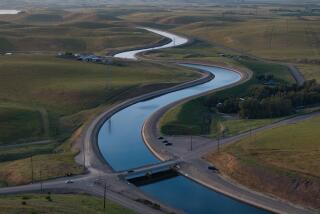Experts Predict Future Water Shortages for California
STATELINE, Nev. â An expanding population could force significant water shortages in California during the next two decades--unless the state develops more storage or improves its delivery systems, experts warn.
Moreover, some of the experts say that moving surplus water from rain-rich Northern California to Southern California is a top priority and believe that some form of the ill-fated Peripheral Canal--which state voters rejected in a 1982 referendum after an emotional debate--remains feasible.
âThat could be one part of the âdelta solution,â â said David Kennedy, the director of the state Department of Water Resources, referring to the Sacramento-San Joaquin Delta east of San Francisco through which about 80% of the stateâs drinking water flows.
âMaybe a âmediumâ Peripheral Canal,â said Marc Reisner, author of the book âCadillac Desert,â in his keynote speech to about 2,000 people gathered earlier this month at the annual spring conference of the Assn. of California Water Agencies.
The Peripheral Canal, as originally envisioned, was a 44-mile-long concrete ditch, as wide as a 12-lane freeway, skirting the edge of the delta. It would have transferred northern water to the south without requiring massive pumping from the delta, which environmentalists and water officials say can harm the deltaâs ecosystem.
Kennedyâs department has issued a report predicting that California may be short about 3 million acre-feet of water by the year 2020 unless corrective action is taken, including additional storage capacity and delta improvements. The 3 million acre-feet figure is about 10% of what the stateâs 155 major reservoirs normally hold.
A Sierra Club representative disagreed with the expertsâ emphasis on more construction to meet any anticipated water shortage.
The question, Michael Paparian said, is âwhat do you do to meet the need? Do you build more expensive new facilities or do you look at more efficient and cost-effective ways of meeting water needs? Weâve basically found that water conservation is the most effective way of meeting our needs.â
As a result of droughts in the last 20 years, water agencies in California have already implemented a number of conservation measures.
The potential scarcity of water is aggravating the dispute between farmers and builders over the use of rural agricultural land, which is being lost to agriculture through urbanization at the rate of about 1,000 acres a day.
Farmers contend that runaway development threatens their livelihoods.
âItâs safe to say agriculture is being targeted,â David Guy, an attorney with the California Farm Bureau Federation, said at one panel discussion. âThe urban areas see agricultural water and land as their reserve, as something they can develop into.â
Local water agencies, stressed by the overload of new customers, âmust consider denying new service connections to protect the existing water in the system,â he said.
âIf it [protecting the water] requires a moratorium on new water connections, so be it,â Guy said.
But builders said Californiaâs swelling population--itâs at 32.6 million now and growing by about 350,000 annually--creates an undeniable need for more affordable housing.
Cliff Moriyama of the California Building Industry Assn. told the conference that the most affordable housing in California is to be found in the rural farm belts, especially in the Central Valley, which produces a fourth of the nationâs farm products.
âIn some cases, they call it [development] a cancer. But the other side of the equation is the need for new housing to meet the growing populationâs demand,â Moriyama said.
Builders and farmers agreed that a stable water supply is critical to the survival of both industries.
âThereâs going to be an urbanization of agricultural land. We all realize that itâs going to happen,â Kennedy said. âAnd the farm interests, generally, cannot afford new water storage.â
The stateâs major reservoirs now contain about 29 million acre-feet, slightly less than last year at this time but still above average. An acre-foot is equal to about 330,000 gallons, or about what an average family uses in one year.
More to Read
Sign up for Essential California
The most important California stories and recommendations in your inbox every morning.
You may occasionally receive promotional content from the Los Angeles Times.










